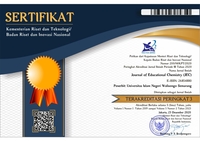The Implementation of Culturally Responsive Teaching to Improve Students' Learning Outcomes and Activity
DOI:
https://doi.org/10.21580/jec.2023.5.2.16407Keywords:
activity, culturally responsive teaching, learning outcomeAbstract
This study aims to determine the increase in students’ learning outcomes and activity through the implementation of Culturally Responsive Teaching (CRT) to solubility and solubility product material in Class XI-MIPA G SMAN 1 Kediri. This research was conducted using the classroom action research model developed by Kemmis and Taggart which consisted of plan, action, observe, and reflect in two cycles. The data obtained was in the form of quantitative data, namely learning outcomes and qualitative data, namely observation sheets. Quantitative data analysis was carried out using descriptive statistical techniques with percentage formulas and descriptions for qualitative data. In the pre-action, students’ learning outcomes and activity were obtained with a mean of 57.2 and 63.8. In Cycle I, students’ learning outcomes increased by an average of 80.0 and students’ activity increased by an average of 71.4, while students’ learning outcomes increased by 89.1 and students’ activity increased by 91.4 in Cycle II. The results showed that the implementation of CRT can improve students’ learning outcomes and activity in Class XI-MIPA G SMAN 1 Kediri.
Downloads
References
Arikunto, S. 2015. Penelitian Tindakan Kelas. Jakarta: Bumi Aksara.
Asiyah, S. 2022. Meningkatkan Hasil Belajar Kimia Tata Nama Senyawa Sederhana dengan Model Think-Pair-Share pada Siswa Kelas X SMA Negeri 1 Lingsar. Reflection Journal, 2(1), 17–25.
Badan Standar Nasional Pendidikan. 2010. Paradigma Pendidikan Nasional Abad XXI. Jakarta: Kementerian Pendidikan dan Kebudayaan.
Gay, G. 2001. Culturally Responsive Teaching: Theory, Practice, and Research. New York: Teachers College Press.
Hernandez, C. M., Morales, A. R. and Shroyer, M. G. 2013. The Development of A Model of Culturally Responsive Science and Mathematics Teaching. Cultural Studies of Science Education, 8(4), 803–820.
Ismawati, R. 2017. Strategi REACT Dalam Pembelajaran Kimia SMA. Indonesian Journal of Science and Education, 1(1), 1–7.
Kemendikbud. 2015. Peraturan Menteri Pendidikan dan Kebudayaan Republik Indonesia Nomor 53 Tahun 2015 Tentang Penilaian Hasil Belajar oleh Pendidik dan Satuan Pendidikan pada Pendidikan Dasar dan Pendidikan Menengah. Jakarta: Kementerian Pendidikan dan Kebudayaan.
Nisa, A., Sudarmin and Samini. 2015. Efektivitas Penggunaan Modul Terintegrasi Etnosains dalam Pembelajaran Berbasis Masalah untuk Meningkatkan Literasi Sains Siswa. USEJ - Unnes Science Education Journal, 4(3), 1049–1056.
Rafiuddin, R., Dali, A. and Anton, L. O. R. 2018. Penerapan Model Problem Based Learning (PBL) Berbasis Pendekatan Saintifik untuk Meningkatkan Penguasaan Konsep pada Materi Pokok Kelarutan dan Hasil Kali Kelarutan. JRPK: Jurnal Riset Pendidikan Kimia, 8(2), 1–10.
Rahmawati, Y., Baeti, H. R., Ridwan, A., Suhartono, and Rafiuddin. 2019. A Culturally Responsive Teaching Approach and Ethnochemistry Integration of Tegal Culture for Developing Chemistry Students’ Critical Thinking Skills in Acid-Based Learning. Journal of Physics: Conference Series, 1402(5): 1-6.
Rahmawati, Y., Ridwan, A., Cahyana, U., and Febriana, D.. 2020. The Integration of Culturally Responsive Transformative Teaching to enhance Student Cultural Identity in The Chemistry Classroom. Universal Journal of Educational Research, 8(2), 468–476.
Rahmawati, Y. and Ridwan, A. 2017. Empowering Students’ Chemistry Learning: The Integration of Ethnochemistry in Culturally Responsive Teaching. Chemistry: Bulgarian Journal of Science Education, 26(6), 813–830.
Sudiana, I. K. S., Suja, I. W. and Mulyani, I. 2019. Analisis Kesulitan Belajar Kimia Siswa pada Materi Kelarutan dan Hasil Kali Kelarutan. Jurnal Pendidikan Kimia Indonesia, 3(1), 1-7.
Sufyadi, S., Lambas, Rosdiana, T., Rochim, F. A. N., Novrika, S., Iswoyo, S., Hartini, Y., Primadona, M., and Mahardhika, R. L.. 2021. Pembelajaran Paradigma Baru. Jakarta: Badan Penelitian dan Pengembangan dan Perbukuan.
Suparlan, H. 2016. Filsafat Pendidikan Ki Hadjar Dewantara dan Sumbangannya Bagi Pendidikan Indonesia. Jurnal Filsafat, 25(1), 60-73.
Utari, R., Andayani, Y. and Savalas, L. R. T. 2020. Pengembangan Modul Kimia Berbasis Etnosains Dengan Mengangkat Kebiasaan Petani Garam. Jurnal Pijar MIPA, 15(5), 478–481.
Wiryopranoto, S., Herlina, N., Djoko, M., Tangkilisan, Y. B.. 2017. Ki Hajar Dewantara Pemikiran dan Perjuangannya. Jakarta: Museum Kebangkitan Nasional Direktorat Jenderal Kebudayaan Kementerian Pendidikan dan Kebudayaan.
Downloads
Published
How to Cite
Issue
Section
License
The copyright of the received article shall be assigned to the journal as the publisher of the journal. The intended copyright includes the right to publish the article in various forms (including reprints). The journal maintains the publishing rights to the published articles.
Authors are permitted to disseminate published articles by sharing the link/DOI of the article at the journal. Authors are allowed to use their articles for any legal purposes deemed necessary without written permission from the journal with an acknowledgment of initial publication to this journal.

This work is licensed under a Creative Commons Attribution-NonCommercial-ShareAlike 4.0 International License.


